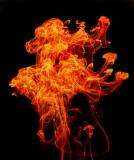Artificial Intelligence Drafted to
Tackle Wildfire Risks

Wildfires have become a regular feature of our summer news bulletins. Once again, this year has seen loss of life in California, and fires on Greek islands contributed to a water shortage that pushed Greece’s tourism sector towards crisis. And then there is the annual hit taken to efforts to manage climate change.
Trees play a vital role in absorbing carbon dioxide, arguably making them the most effective force to halt or reverse climate change effects. Wildfires not only undo all the hard work of planting and growing forests but also release huge amounts of carbon dioxide and other harmful greenhouse gases into the atmosphere. As carbon dioxide is released, temperatures rise, and the risk and frequency of wildfires grow.
Whether to safeguard the lives of humans and wildlife, or to reduce the impact on economies, or to care for the environment, finding better ways to detect and tackle wildfires is becoming an
increasingly urgent issue.
Once Upon a Time
Early in the twentieth century, the U.S. Forest Service built lookout towers to spot fires. Since before the Great War to this day, the start of the fire season has seen a small army of men and women deployed to scan treetops, ever on the lookout for smoke on the horizon. As time and technology moved on, backup arrived in the form of fire-spotting aircraft and satellites. Even the towers have received upgrades with cameras performing a great deal of the treetop monitoring. And now, Artificial Intelligence (AI) has joined the fray.
Wildfire Prediction with AI Assistance
Although predicting the exact start location of a wildfire is challenging, calculating the risk can help us achieve reasonable prediction accuracy. Currently, fire risk is determined predominantly based on weather information obtained from satellites and, where available, enhanced with data from local weather stations. Fire risk is then calculated on a rather coarse scale (e.g., with one square kilometer resolution) and published on news channels to alert the public of a heightened threat by wildfires.
More advanced calculations are based on VPD (vapor pressure deficit) which is the difference between the amount of moisture that's actually in the air and the amount of moisture that air could hold at saturation. From a wildfire perspective, consistently elevated VPD means that ecosystems can more easily ignite and spread fire, leading to the larger, higher-severity wildfires.
Calculating fire risk levels, taking into account various sources of information (satellite, weather stations, and potentially local sensors), and then mapping the risk on a fine-grained scale is a complex and tedious task which can be automated and enhanced in accuracy and resolution with the help of AI. Of course, adding more fine-grained information such as soil and air moisture levels measured by sensors embedded in the forest would help to take into account the microclimate of the forest. In the future, we might be able to push this even further if we could find a technical solution for measuring the fuel moisture (grass and needles), rather than just the soil moisture.
AI-based wildfire detection works by leveraging machine learning algorithms to analyze data from various sensors and detect the presence of a fire. Unlike traditional methods of fire detection that rely on human observation, AI can process vast amounts of data and identify patterns that indicate the presence of a fire.
The machine learning models used for fire detection are trained on large datasets that include both fire and non-fire scenarios to accurately identify fires based on the characteristics of smoke and other factors. The models are also rigorously trained to reduce the prevalence of false positive fire alerts.
Camera Detection and AI
Camera detection works by using a camera on a watchtower overlooking a large area of forest. Traditionally, these watchtowers were manned by people keeping a lookout, but are increasingly being monitored by cameras.
Machine learning and AI image recognition can be used to identify the presence of smoke or fire plumes rising above the canopy. Image recognition technology has been around for some time and has proven to be effective in various applications. In the context of wildfire detection, cameras are used to capture images of the forest above the canopy and analyze them for the presence of smoke. However, this method faces several challenges.
One of the main challenges with camera-based detection is the occurrence of false positives. Agricultural machinery might throw up dust during field plowing, for example, and even wind farms can
be mistaken for smoke plumes from a large distance. Weather conditions, such as haze or fog, can also make it difficult for cameras to accurately identify smoke, and the time of day, particularly
dawn, dusk, and nighttime,



















